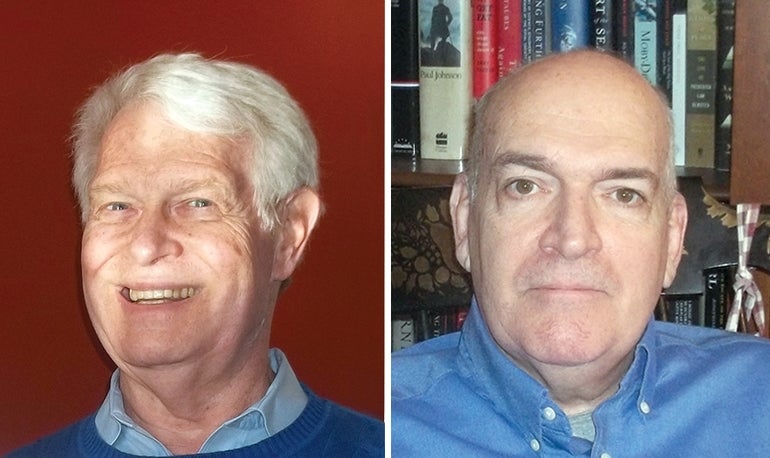After 24 years of research, Robert Krim and Alan Earls released in February their book on innovations in Massachusetts, focusing on 50 particular ones, including three from Central Massachusetts.
Get Instant Access to This Article
Subscribe to Worcester Business Journal and get immediate access to all of our subscriber-only content and much more.
- Critical Central Massachusetts business news updated daily.
- Immediate access to all subscriber-only content on our website.
- Bi-weekly print or digital editions of our award-winning publication.
- Special bonus issues like the WBJ Book of Lists.
- Exclusive ticket prize draws for our in-person events.
Click here to purchase a paywall bypass link for this article.
After 24 years of research, Robert Krim and Alan Earls released in February their book on innovations in Massachusetts, focusing on 50 particular ones, including three from Central Massachusetts.
Why write this book about Massachusetts?
Krim: There is no place in the United States that has done what we’ve done. Massachusetts has had four major economic collapses in our 400 years, and we have invented new ways to come out of that, with new industries. For example, when the clipper ship economy collapsed, we came up with a much cheaper way to make shoes, and that became a new basis for the economy.
“Boston Made” is a book about Massachusetts innovations that have changed the world. We found in doing the research for this, over 20 years, there are 400 Massachusetts innovations that have changed the nation or the world.
This makes Massachusetts one of the most innovative regions in the world.
Why is it one of the most innovative?

Krim: We researched 24 different regions as to why this is the one of the most innovative regions in the world. The five reasons for this:
• Dynamic entrepreneurs
• Vibrant network for supporting those entrepreneurs
• Local funding for innovation
• Local demand, as in people who wanted to buy the product as early adopters
• Global demand for the finished product
Earls: Innovation is remarkably well supported in Massachusetts. People still reach out to me about the 128 corridor phenomenon. Having that level of invention and support in one place is somewhat unique in the world.
What Central Massachusetts innovations are featured?
Krim: Three very different ones come from the Central Massachusetts region. First was the innovation and the launch of the first rocket in the world by Robert Goddard.
Second was the development of the first college to teach teachers in the United States: 1839 at what is now named Framingham State University. The person who played a critical role in that was Horace Mann of Franklin, who invented the idea of a public school system in the state. Critical to that was having a college to train teachers.
Earls: Third came from the gentleman who invented the smiley face: Harvey Ball. He is the grandfather of all the emojis we use today.
Krim: These three are part of the 50 innovations featured in the book. We didn’t think people would buy a book with 400 detailed descriptions of innovations.
What other Massachusetts inventions are featured?
Krim: We have innovations like the telephone, microwave oven, and the first organ transplant. We have social innovations, too, like the abolishment of slavery.
Earls: Bob’s dad was a friend of the man who invented the microwave, and Bob’s kitchen growing up was home to one of the first experimental microwaves.
Boston helped lead the western world in inoculations, which you can see help lead the way for Massachusetts companies like Moderna to develop a COVID-19 vaccine.
What makes a region innovative?
Krim: You have to have many of the support systems in space. Boston is the first city in the Western Hemisphere to have a subway, and that couldn’t have happened without the electric generator developments in Lynn.
You have to have innovators who can break through to get the thing developed, but then you have to have people who buy.
You have to have people who fund it. You can have a great idea, but if you can’t find people willing to fund it, you’ll never make it to the market.
Now, for a company like Moderna, to get this funding, you need venture capital. The concept of venture capital was invented by a Harvard Business School professor named George Doriot. He had served in the military and revolutionized supply chains and military production. Because he was worried the country wouldn’t be as innovative as it was during World War II, he started the American Research and Development Corp., which funded companies started by soldiers returning to the private sector.
What made you want to write a book?
Krim: This started in 1997, and this book is the result of decades of research, and hundreds of people being involved along the way. As I have been teaching students over the past decades, what is now the book were simply writings I had made about all these inventions.
Earls: My life focus has been the post-World War II growth of electronics. So many of the people and resources who were focused on old industries were able to focus on the next generation. There are a lot of interconnections as this 400-year-old story proceeds.
This interview was conducted and edited for length and clarity by WBJ Editor Brad Kane.

